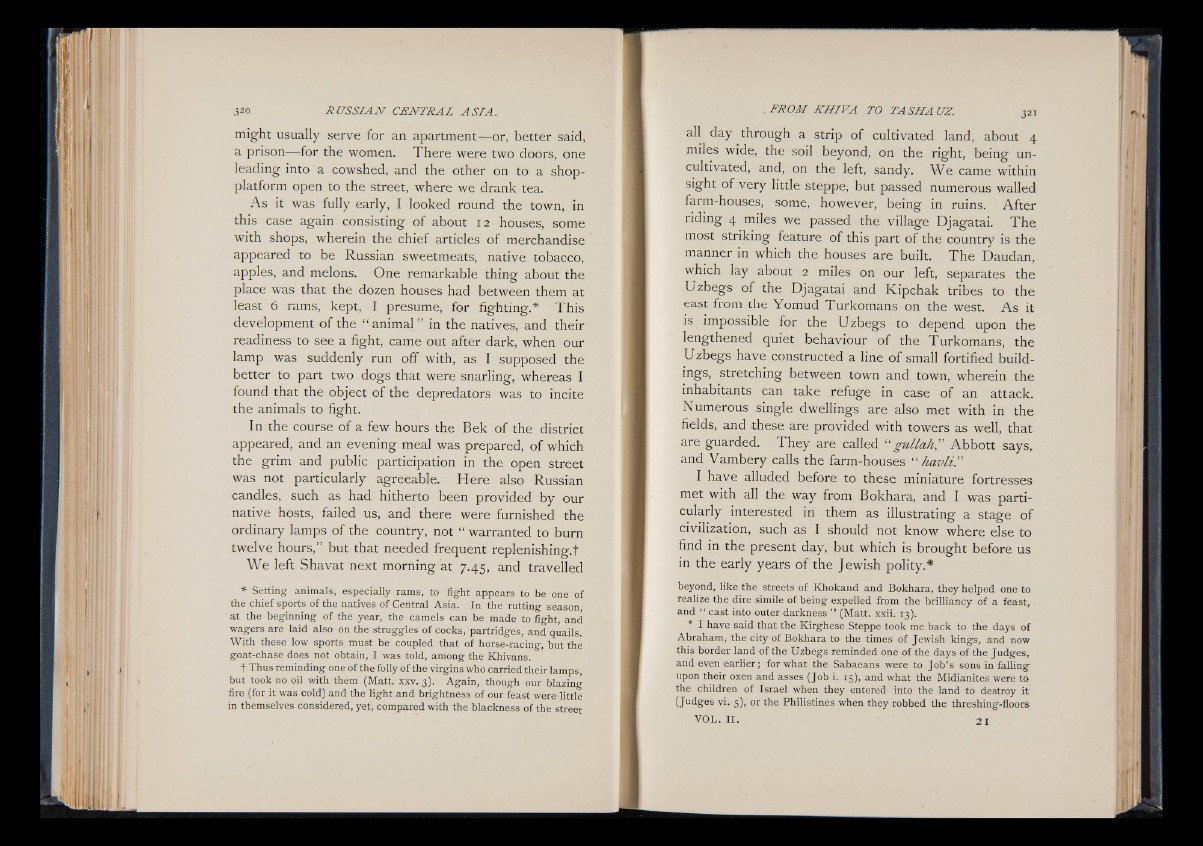
might usually serve for an apartment— or, better said,
a prison— for the women. There were two doors, one
leading into a cowshed, and the other on to a shop-
platform open to the street, where we drank tea.
A s it was fully early, I looked round the town, in
this case again consisting of about 12 houses, some
with shops, wherein the chief articles of merchandise
appeared to be Russian sweetmeats, native tobacco,
apples, and melons. One remarkable thing about the
place was that the dozen houses had between them at
least 6 rams, kept, I presume, for fighting.* This
development of the “ animal” in the natives, and their
readiness to see a fight, came out after dark, when our
lamp was suddenly run off with, as I supposed the
better to part two dogs that were snarling, whereas I
found that the object of the depredators was to incite
the animals to fight.
In the course of a few hours the Bek of the district
appeared, and an evening meal was prepared, of which
the grim and public participation in the open street
was not particularly agreeable. Here also Russian
candles, such as had hitherto been provided by our
native hosts, failed us, and there were furnished the
ordinary lamps of the country, not “ warranted to burn
twelve hours,” but that needed frequent replenishing.f
We left Shavat next morning at 7.45, and travelled
* Setting animals, especially rams, to fight appears to be one of
the chief sports of the natives of Central Asia. In the rutting season
at the beginning of the year, the camels can be made to fight, and
wagers are laid also on the struggles of cocks, partridges, and quails.
With these low sports must be coupled that of horse-racing, but the
goat-chase does not obtain, I was told, among the Khivans.
t Thus reminding one of the folly of the virgins who carried their lamps,
but took no oil with them (Matt. xxv. 3). Again, though our blazing
fire (for it was cold) and the light and brightness of our feast were little
in themselves considered, yet) compared with the blackness of the street
all day through a strip of cultivated land, about 4
miles wide, the soil beyond, on the right, being uncultivated,
and, on the left, sandy. W e came within
sight of very little steppe, but passed numerous walled
farm-houses, some, however, being in ruins. After
riding 4 miles we passed the village Djagatai. The
most striking feature of this part of the country is the
manner in which the houses are built. T h e Daudan,
which lay about 2 miles on our left, separates the
Uzbegs of the Djagatai and Kipchak tribes to the
east from the Yomud Turkomans on the west. A s it
is impossible for the Uzbegs to depend upon the
lengthened quiet behaviour of the Turkomans, the
Uzbegs have constructed a line of small fortified build-
ings, stretching between town and town, wherein the
inhabitants can take refuge in case of an attack.
Numerous single dwellings are also met with in the
fields, and these are provided with towers as well, that
are guarded. They are called “ gullah," Abbott says,
and Vambery calls the farm-houses “ havli.”
I have alluded before to these miniature fortresses
met with all the way from Bokhara, and I was particularly
interested in them as illustrating a stage o f
civilization, such as I should not know where else to
find in the present day, but which is brought before us
in the early years o f the Jewish polity.*
beyond, like the streets of Khokand and Bokhara, they helped one to
realize the dire simile of being expelled from the brilliancy of a feast,
and “ cast into outer darkness ” (Matt. xxii. 13).
* I have said that the Kirghese Steppe took me back to the days of
Abraham, the city of Bokhara to the times of Jewish kings, and now
this border land of the Uzbegs reminded one of the days of the Judges,
and even earlier; for what the Sabaeans were to Job’s sons in falling
upon their oxen and asses (Job i. 15), and what the Midianites were to
the children of Israel when they entered into the land to destroy it
(Judges vi. 5), or the Philistines when they robbed the threshing-floors